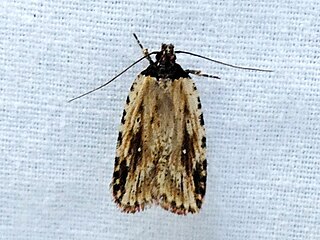Agonopterix antennariella is a moth in the family Depressariidae. It was described by John Frederick Gates Clarke in 1941. It is found in Washington, British Columbia and western Greenland.
Agonopterix cajonensis is a moth in the family Depressariidae. It was described by John Frederick Gates Clarke in 1941. It is found in North America, where it has been recorded from California.
Agonopterix costimacula is a moth in the family Depressariidae. It was described by John Frederick Gates Clarke in 1941. The Global Lepidoptera Names Index lists it as a synonym of Agonopterix nigrinotella. It is found in North America, where it has been recorded from Maryland, Michigan, Ohio and Ontario.
Agonopterix dimorphella is a moth in the family Depressariidae. It was described by John Frederick Gates Clarke in 1941. It is found in North America, where it has been recorded from South Carolina, Illinois, Nebraska, Kansas and Arkansas.
Agonopterix fusciterminella is a moth in the family Depressariidae. It was described by John Frederick Gates Clarke in 1941. It is found in North America, where it has been recorded from California to southern British Columbia, as well as from North Carolina and Tennessee.
Agonopterix oregonensis is a moth in the family Depressariidae. It was described by John Frederick Gates Clarke in 1941. It is found in North America, where it has been recorded from California to southern British Columbia.
Agonopterix muricolorella is a moth in the family Depressariidae. It was described by August Busck in 1902. It is found in North America, where it has been recorded from Colorado, eastern Oregon and eastern Washington.
Agonopterix nigrinotella is a moth in the family Depressariidae. It was described by August Busck in 1908. It is found in North America, where it has been recorded from Arkansas, Illinois, Indiana, Maine, Maryland, Michigan, Minnesota, New York, Ohio, Ontario, Quebec and Wisconsin.
Agonopterix pergandeella is a moth in the family Depressariidae. It was described by August Busck in 1908. It is found in North America, where it has been recorded from Minnesota and Nebraska.
Agonopterix sanguinella is a moth in the family Depressariidae. It was described by August Busck in 1902. It is found in North America, where it has been recorded from Arizona, New Mexico and Nevada.

Agonopterix senicionella is a moth in the family Depressariidae. It was described by August Busck in 1902. It is found in North America, where it has been recorded from Kentucky, Michigan, Ohio, Virginia and West Virginia.
Agonopterix walsinghamella, or Walsingham's agonopterix moth, is a moth in the family Depressariidae. It was described by August Busck in 1902. It is found in North America, where it has been recorded from the north-eastern United States and Canada.

Agonopterix atrodorsella is a species of moth in the family Depressariidae. It was first described by James Brackenridge Clemens in 1863. It is found in North America, where it has been recorded from Illinois, Indiana, Kentucky, Maine, Maryland, Massachusetts, Michigan, New Brunswick, New Hampshire, New York, North Carolina, Ohio, Ontario, Quebec and Wisconsin.

Agonopterix curvilineella, the curved-line agonopterix moth, is a species of moth in the family Depressariidae. It was first described by William Beutenmüller in 1889. It is found in North America, where it has been recorded from Illinois, Indiana, Kentucky, Maine, Maryland, Massachusetts, Michigan, Minnesota, Mississippi, New Brunswick, New York, Ohio, Ontario, Quebec, Tennessee, West Virginia and Wisconsin.
Agonopterix hesphoea is a moth in the family Depressariidae. It was described by Ronald W. Hodges in 1975. It is found in North America, where it has been recorded from Texas.
Agonopterix hyperella is a moth in the family Depressariidae. It was described by Charles Russell Ely in 1910. It is found in North America, where it has been recorded from Alabama, Indiana, Maryland, Massachusetts, North Carolina, Ohio and Tennessee.
Agonopterix latipalpella is a moth in the family Depressariidae. It was described by William Barnes and August Busck in 1920. It is found in North America, where it has been recorded from Texas.
Agonopterix lecontella is a moth in the family Depressariidae. It was described by James Brackenridge Clemens in 1860. It is found in North America, where it has been recorded from Pennsylvania.
Agonopterix pteleae is a moth in the family Depressariidae. It was described by William Barnes and August Busck in 1920. It is found in North America, where it has been recorded from Illinois, Michigan and Ohio.
Agonopterix toega is a moth in the family Depressariidae. It was described by Ronald W. Hodges in 1974. It is found in North America, where it has been recorded from California.


